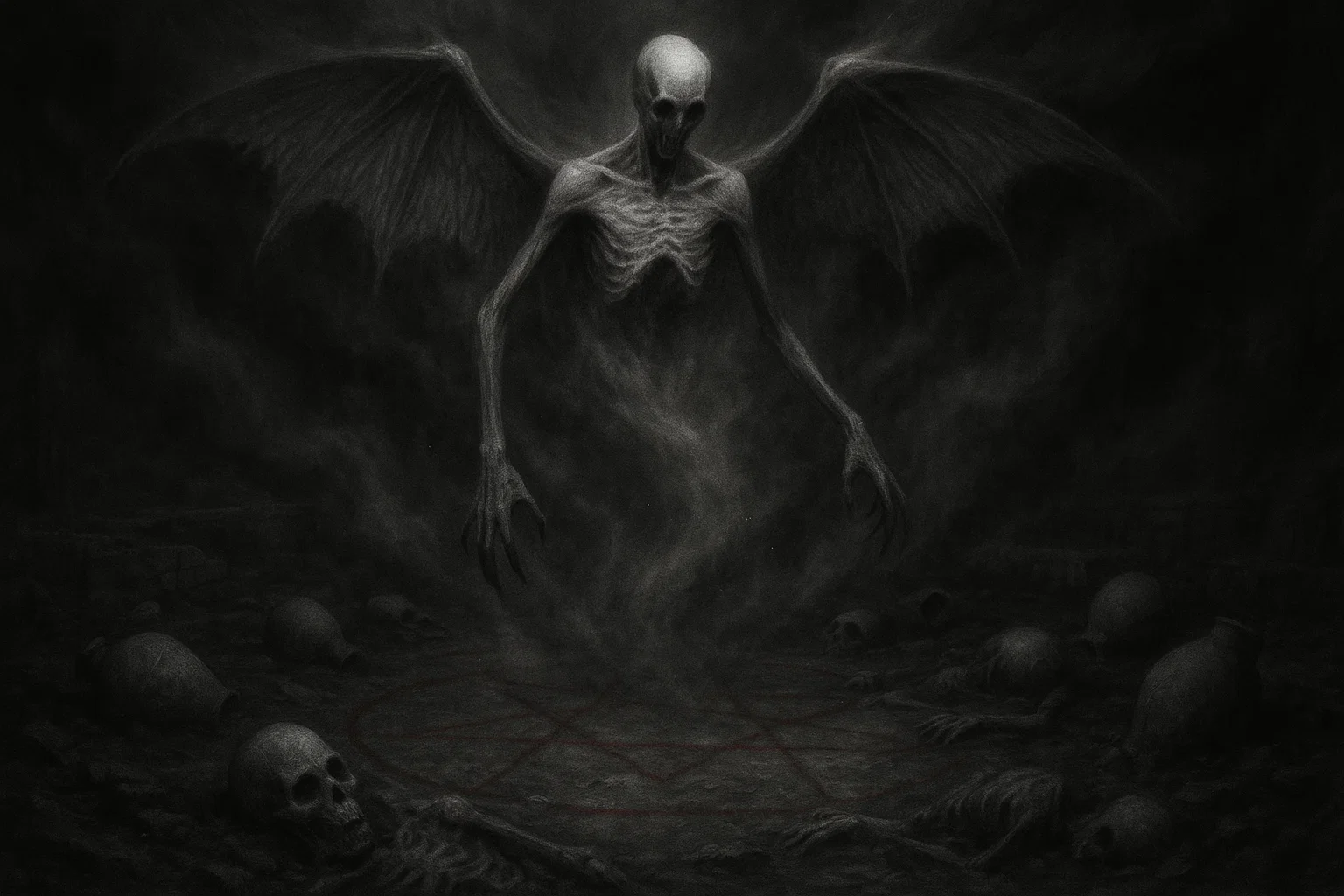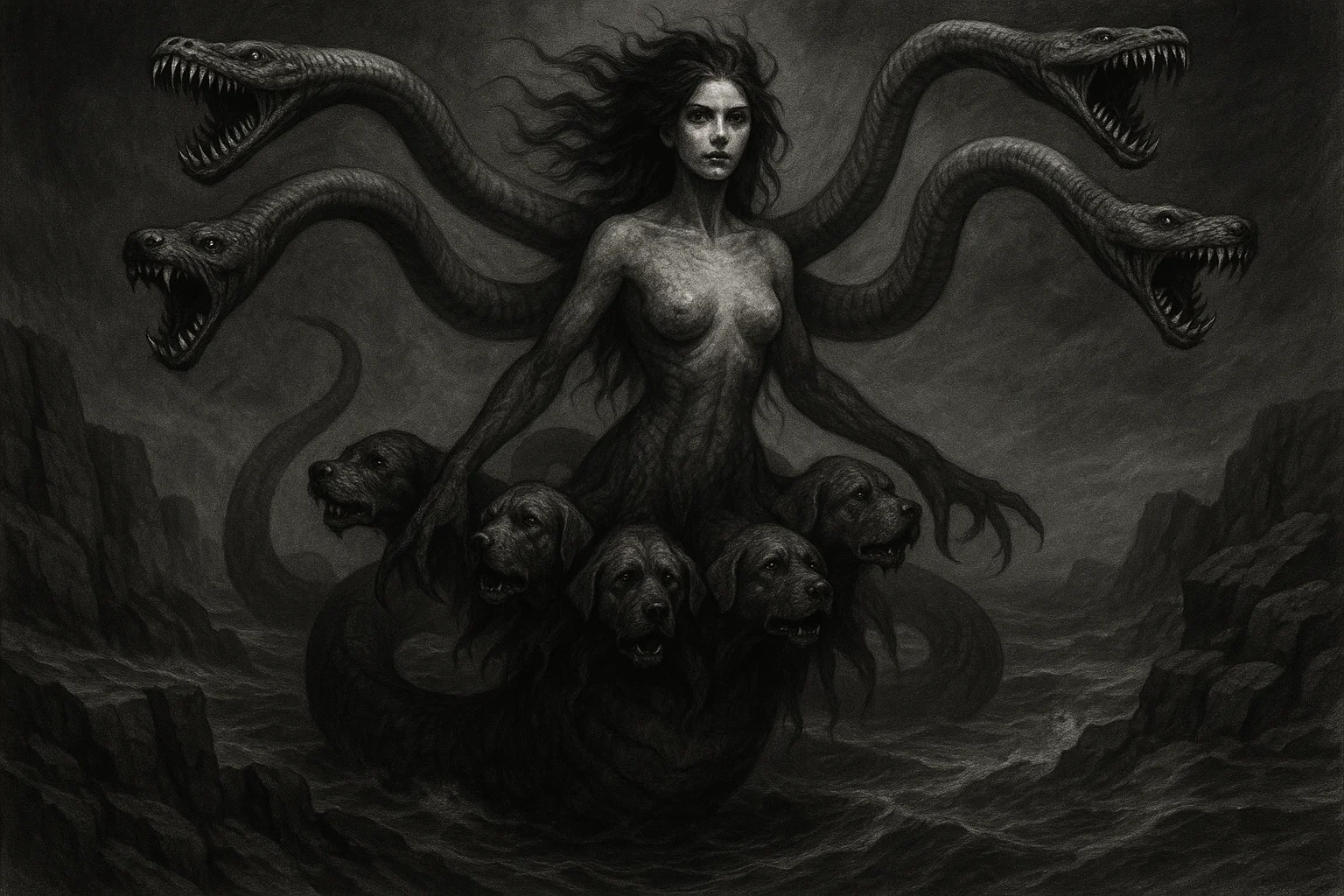In the scorched cradle of ancient Mesopotamia, where the relentless sun baked the clay tablets of forgotten scribes and the Tigris winds carried echoes of the unquiet dead, the Edimmu—those spectral harbingers of retribution—slithered from the parched lips of graves left unsealed by neglectful hands.
These demonic wind spirits, forged from the furious essences of souls denied their subterranean slumber in the grim halls of Kur, prowled the night as invisible predators, their ethereal gales laced with the chill of unresolved betrayals and the hunger for stolen life force.
Born of Sumerian dread and amplified through Akkadian incantations, the Edimmu embodied the raw terror of improper burial rites, a Mesopotamian demon whose whispers could twist the pious into criminals, drain the vitality from slumbering infants, and unleash plagues upon entire city-states like Uruk or Nippur.
What ancient taboo might summon such a vengeful revenant to your threshold, forcing you to confront the fragility of your own mortality? Could the faint howl in a desert storm be the prelude to possession, where a single overlooked funerary libation invites this life-sucking shade to feast on your family’s essence?
Summary
Key Information
| Category | Details |
|---|---|
| Name | Edimmu (Sumerian core term for wind ghost); Ekimmu (Akkadian variant, often linked to vampiric readings); Utukku Edimmu (subtype within spirit hierarchies); Gidim Edimmu (Sumerian ghost-wind hybrid); Rabisu Edimmu (lurking ambush form in Assyrian texts) |
| Title | Vengeful Wind Demon; Unquiet Revenant; Spectral Life-Drainer; Taboo Avenger; Plague-Bearing Gale; Corpse-Wind Fiend |
| Gender | Amorphous and neutral; manifests aggressively as masculine in possession assaults but fluidly inhabits any vessel, preying indifferently on male, female, or child |
| Role | Enforcer of funerary taboos through haunting and affliction; possessor inducing criminality, disease, and decay; harbinger of societal collapse via wind-borne curses; tempter toward moral dissolution in Mesopotamian demonology |
| Hierarchy | Lower-tier utukku operative in Kur’s chaotic underclass; subordinate to chthonic overlords but autonomous in grudge pursuits; no Christian infernal ladder equivalent, yet akin to mid-level fiends in Babylonian cosmic disorder |
| Servitors | Lesser alû (faceless night demons); dimme (fever-inducing shades); rabisu (ambush lurkers); minor gidim swarms drawn from familial unburied; occasional rabid wind imps in Assyrian horde depictions |
| Superior Demon | Ereshkigal (Irkalla’s unyielding queen, commanding all netherworld unrest); Nergal (plague-warlord consort, directing death’s tempests); Hanbi (primal evil sire of lilû wind hordes); Pazuzu (wind-king rival, occasionally co-opting for greater storms) |
| Powers | Vital essence siphoning through chilling gusts; insidious possession sparking taboo crimes like sacred beast slaughter; miasmic fogs birthing epidemics; illusory whispers amplifying grudges into feuds; storm-summoning for mass affliction; blood-tainted winds evoking vampiric thirst in later lore |
| Appearance | Ethereal vortex of dust and shadow, coalescing into gaunt, elongated corpse with hollow orbits and feathered membrane; bat-winged humanoid void in Akkadian seals; pallid, elongated claws phasing through flesh; faceless maw exhaling accusatory sighs |
| Etymology | Sumerian e-dim or gidim-ma (“house wind” or “rising ghost”); Akkadian edimmu from edi (“ascend”) + mu (spectral essence); ties to utukku (spirit ascent from grave); echoes Proto-Semitic ʕdm (bloody unrest) in vampiric evolutions |
| Associated Figures | Lamashtu (child-plaguing ally in nocturnal raids); Gallu (underworld draggers, occasional summoners); Dumuzi (descent archetype mirroring unburied plaints); Anzu (storm-bird thief, wind-kin rival); global kin like Preta (Hindu hungry ghosts) and Jiangshi (Chinese hopping vampires) |
| Weaknesses | Ritual libations of beer, blood, and water at sealed graves; Pazuzu-head amulets redirecting gales; Ea’s incantations naming the invader; cedar fumigations scattering form; bronze mirrors channeling Utu’s blaze; communal taboo observances like ox-flesh avoidance |
| Opposing Angel/Saint | Shedu (bull-guardian spirits as divine bulwarks); Utu/Shamash (solar exposer of shadows); Ea/Enki (abzu’s cunning exorcist); no saintly Christian parallel, but akin to Raphael’s plague-repelling in apocryphal ties |
| Equipment/Tools | Whispering zephyrs as temptation conduits; shadowy tendrils for soul-clasping; grave-dust veils for invisibility; ethereal sickles mimicking scythes in harvest myths; blood-mist phials in Babylonian evocations |
| Pantheon | Mesopotamian (Sumerian, Akkadian, Babylonian, Assyrian); core to Anunnaki chthonic domain under Kur; influences Hittite and Hurrian wind-fiends; echoes in Levantine Rephaim shades |
Etymology
The etymology of Edimmu plunges us into the intricate wedge-script of Sumerian cuneiform, where words were not idle labels but potent invocations etched against the caprice of fate.
Rooted in the archaic Sumerian e-dim—literally “wind of the house” or “domestic gale”—the term fuses e (house or abode) with dim (binding wind or feverish spirit), evoking a spectral intruder that breaches the hearth’s sanctity like a sandstorm through reed walls.
This primal formulation, attested in Early Dynastic III tablets from Fara (circa 2600 BCE), underscores the Edimmu‘s domestic horror: not a distant thunder, but an intimate draft carrying the dead’s grievances, punishing families for burial lapses with intimate afflictions like cradle-snatching gusts or nocturnal fevers.
As Sumerian yielded to Akkadian dominance around 2300 BCE, the name morphed into edimmu, a Semitic inflection blending edi (“to rise up” or “ascend violently”) with mu (a suffix denoting ethereal essence or “who?”), implying “that which rises unnamed from the grave.”
Lexical lists from Ebla and Abu Salabikh equate it to utukku edimmu, classifying it within the utukku spectrum—broadly “spirits that emerge”—where benevolent shedu coexisted uneasily with malevolent gallu. Phonetic drift produced the erroneous ekimmu, a scribal misreading of eroded wedges in Nineveh library fragments, popularized in 19th-century Assyriology but now dismissed as a calque for its vampiric overtones, evoking eku (“to seize” or “devour”).
Deeper philological layers reveal ties to Proto-Semitic ʕdm (“to be red” or “bloodied”), hinting at the Edimmu’s sanguinary evolution in Babylonian texts, where winds “drink the blood of man” like Lamashtu’s feasts.
Sumerian hymns, such as the Lugal-e epic’s underworld passages (circa 2100 BCE), invoke gidim edimmu (“ghost wind”) alongside dimme (fever binders), sharing dim roots in “to bind darkly” or “feverish coil,” symbolizing the spirit’s constricting grasp on the afflicted. Nippur god-lists pair it with lilu (night winds), suggesting lu (“person”) + dim (“twisted”), a “perverted soul” ascending against Irkalla’s seven-gated repose.
Comparative linguistics extends these roots globally: Sumerian dim parallels Vedic preta (“departed” hungry ghost) via Indo-European *dʰeh₁m- (“to place/bind”), both denoting bound unrest.
In Ugaritic, akin to *rpu* (shades), it echoes Levantine Rephaim—hero-ghosts denied rest—while Egyptian ꜥk̚m (“enterer,” akin to akh spirits) shares the invasive ascent motif. By Neo-Assyrian times (911–609 BCE), edimmu accrued zaqiqu (“screeching wind”) connotations, linking to Hurrian wind-fiends like Teshub’s storms.
Thus, the Edimmu‘s name is a palimpsest of ascent, blood, and binding—a linguistic curse that, when uttered in Maqlû rites, unravels the demon’s windy coil, reminding scribes that to name the unrest is to begin its chaining.
This etymological depth illuminates Mesopotamian demonology‘s core: language as both summoner and slayer of the spectral, where a syllable’s shift could mean the difference between repose and raging gale.
In lexical compendia like the HAR-ra-hubullu series (Old Babylonian, circa 1800 BCE), Edimmu clusters with etimmu (evil wind) and pazuzu derivatives, foreshadowing wind-king rivalries. Hittite adaptations as h̬aššuš (“storm ghost”) during Mitanni exchanges (1500 BCE) infuse Indo-Aryan asura (demonic rival) flavors, while Phoenician ʾdm (“blood-red spirit”) bridges to biblical “shades” in Isaiah 14.
These interconnections portray the Edimmu as a migratory malediction, its name evolving like the very winds it commands, from Sumerian hearth-haunt to Babylonian blood-thirst, eternally whispering accusations across the lexical winds of the ancient Near East.
You May Also Like: Asag: The Grotesque Plague-Bringer Demon of Mesopotamia
What Does the Demon Edimmu Look Like?
The Edimmu shuns corporeal permanence, favoring the treacherous fluidity of a sand-laced sirocco that coalesces only to strike, its form a mocking echo of the unburied husk it once was.
Primarily an incorporeal maelstrom, it manifests as a churning haze of grave-dust and shadow, tendrils of chill vapor coiling like serpents around the unwary, often bearing the faint outline of a humanoid silhouette—elongated, emaciated, with limbs stretched taut as if dragged by Kur’s inexorable pull.
In Sumerian incantation bowls from Larsa (circa 2000 BCE), this haze solidifies into a pallid cadaver: fleshless cheeks hollowed like eroded ziggurats, orbits yawning black as Irkalla’s gates, and a torso sheathed in a translucent, bird-feathered membrane that rustles with predatory intent, evoking Anzu’s stolen plumage in thievish flight.
Distinctive traits amplify its visceral dread: claws extended into wispy scythes that phase through skin to rake the soul’s tether, leaving victims shivering with phantom lacerations; a mawless face dissolving into a vortex that inhales še (breath-life) with guttural sighs of accusation; and an aura of ashen luminescence, flickering like foxfire over steppe barrows, illuminating elongated fingers stained with ethereal blood from imagined feasts.
Akkadian cylinder seals from Ashur (ninth century BCE) depict it as a bipedal abomination—bat-eared and wing-membraned, hovering on gusts with no lower limbs, its torso a seamless void where entrails should writhe, trailing dust-devils that choke livestock in their pens.
In Babylonian medical papyri, rarer corporeal visions include a “walking drought”: skin desiccated to parchment, eyes milky with subterranean gloom, and a crown of swirling locust-wings mimicking Abaddon’s swarms, though stripped of insectile form for pure spectral malice.
These attributes render the Edimmu a psychological scourge, its shape-shifting haze dissolving at Shamash’s first blush, only to reform in twilight’s cradle, where its intangible caress leaves brands of fever and taboo-lust on the flesh it cannot fully claim.
Historical and Mythological Background
The Edimmu‘s origins burrow deep into the alluvial soils of Sumer, circa 4500–2000 BCE, where the world’s first urban theocracy grappled with death’s impermanence amid flood-prone rivers and arid steppes.
Emerging as a subtype of utukku—amorphous spirits embodying cosmic flux—these wind ghosts crystallized from anxieties over kudurru (boundary neglect) and funerary lapses, as detailed in Ur III laments (2112–2004 BCE).
Unlike celestial Anunnaki, Edimmu were chthonic upstarts, souls rebelling against Ereshkigal’s decree by ascending through Kur’s seven gates without oil-anointed repose, their unrest a direct rebuke to Enki’s ordered creation in the Atrahasis epic.
This genesis ties them inextricably to Mesopotamian cosmology: as Nammu’s clay-born humanity toiled under Enlil’s yoke, improper interment—hasty steppe exposures or war-tomb oversights—birthed these fiends, enforcing taboos like ox-meat bans to preserve the dead’s shadowy sustenance.
Globally, Edimmu resonate with restless dead archetypes: Vedic preta (tormented ancestors denied pinda offerings, hungering eternally like Sumerian shades); Chinese jiangshi (hopping vampires rising from unburied plague victims, stiff-limbed ascenders mirroring edi ascent); Germanic draugr (barrow-wraiths swelling with grave-dust, vengeful against kin-neglect); and Slavic upyr (blood-wind revenants, taboo-enforcers in folk rites).
These parallels suggest migratory lore via Silk Road exchanges or Levantine trade, with Hittite h̬aššuš storm-ghosts blending Edimmu winds with Indo-European asura chaos. In Egyptian akh-spirits, the invasive ba soul-flight echoes, while Celtic sidhe-fae “unwelcome guests” punish hearth-taboos, underscoring a universal dread of the unmoored dead as demonic agents of entropy.
You May Also Like: Adrammelech in the Bible: Child Sacrifices and Idolatry
The Unburied Shepherd’s Vengeance
In the shadowed folds of Sumerian pastoral epics, preserved in Nippur’s Gudea Cylinder A fragments (circa 2100 BCE), the tale of the Unburied Shepherd unfolds as a stark parable of kinship’s fragility amid the gods’ indifferent gaze.
Dumuzi-like herder Enki-dul, slain by steppe brigands near Lagash’s irrigation canals, lay exposed under vulture skies—his kin, gripped by famine’s pinch, forgoing the sacred clay-seal and date-palm shroud mandated by Ninhursag’s earth-rites. As hyenas scattered his bones to the wind, Enki-dul’s soul, denied Kur’s dusty embrace, fermented into an Edimmu of seething vortex, its form a whirlwind laced with the bleat of phantom flocks and the iron tang of spilled herder-blood.
Rising on the third moonless night, the spirit infiltrated his village as a deceptive zephyr, cooling fevered brows before coiling into lungs like smoke from a defiled altar.
First victim: his brother, the negligent elder, whom the Edimmu possessed during a harvest feast, compelling him to slaughter and devour the taboo ox—sacred to Gula’s healing—its flesh twisting in his maw to screams of ancestral indictment. Madness cascaded: possessed kin turned blades on kin, igniting blood-feuds that razed reed-huts to embers, livestock bloating with unseen plagues as the wind whispered litanies of greed’s folly.
By dawn’s fourth cycle, the village teetered on annihilation, fields withered to salt under the gale’s ceaseless assault, echoing Enlil’s deluge-punishments but intimate, personal—a vendetta scripted in the dead’s unspoken will.
Salvation dawned through ashipu-priestess Enheduanna’s intervention, descendant of Sargon, who unearthed the shepherd’s scattered remnants via dream-omens from Inanna’s star.
In a rite blending Šurpu purifications with libations of barley-beer and ewe’s blood poured into a clay effigy inscribed with Enki-dul’s reversed name—lud-iknE—she lured the Edimmu to manifestation. As the wind howled accusations of betrayal, Enheduanna shattered the vessel at Utu’s rising, its fragments sinking into the canal’s abzu-waters, anchoring the spirit anew.
This myth, echoed in Descent of Inanna‘s nether-plaints, warns of Edimmu as oikos-avengers: their gales not random, but genealogical reckonings, where one burial’s haste unravels the clan’s cosmic thread, birthing demons from domestic dust.
Possession of the Taboo-Breaker
Old Babylonian chronicles from Sippar’s eclipse-omens (circa 1800 BCE), inscribed on kudurru boundary-stones, narrate the Possession of the Taboo-Breaker as a cautionary eclipse-saga, when lunar shadows thinned the veil to Irkalla’s maw.
Merchant Nanna-iddin, en route from Dilmun’s spice-hauls, halted his caravan amid a sandstorm near Borsippa’s ziggurat—his father, a hasty caravan-master, cremated sans rites after a scorpion-plague, ashes scattered to winds without Ea’s naming-chant.
As Sin’s disc darkened in unnatural midday gloom, an Edimmu—fueled by paternal ire—manifested as a feathered silhouette atop camel-humps, its membrane rustling like date-fronds in drought, exhaling fetid plumes that infiltrated Nanna-iddin’s dreams with visions of opulent hoards guarded by ox-headed sentinels.
The possession unfurled insidiously: first, nocturnal tremors where the merchant awoke clawing at unseen chains, his veins icing as the spirit siphoned še in measured drafts, leaving him gaunt yet fevered with illicit cravings.
By the third eclipse-cycle, whispers escalated to compulsions—he pilfered lapis from Marduk’s temple coffers, its azure shards crumbling to dust in his grasp; assaulted a kin-rival in market-brawls, blades drawing blood that the wind lapped like nectar; and in delirium’s peak, devoured forbidden kid-flesh during a sand-veiled rite, his maw foaming with visions of paternal flames.
Village hysteria bloomed: afflicted neighbors mirrored his crimes, feuds fracturing trade-guilds, epidemics of “wind-sickness”—seizures and sterility—sweeping as the Edimmu‘s gales carried contagion from Zagros tombs, evoking Namtar’s heralds but grudge-specific, targeting taboo’s chain.
Exorcism climaxed in Uruk’s Eanna precinct, where ashipu-mages, invoking Shamash’s eclipse-revealing rays via polished hematite mirrors, exposed the shade’s vortex-core. Chanting Maqlû verses—”Burn the wind that binds, shatter the ghost that rises”—they deployed Pazuzu-plaques, the wind-king’s snarls redirecting the gale into a bitumen-sealed jar, sunk in Euphrates’ depths with ox-horn plugs.
Nanna-iddin, purged, etched atonement-stelae vowing eternal libations, his tale a fulcrum in Akkadian omen-lore: Edimmu as eclipse-envoys, their possessions not mere hauntings but celestial indictments, where taboo’s breach invites solar-lunar wrath to incarnate as familial fiend.
You May Also Like: Naamah: The Seductive Demon Queen of Infernal Desires
The Wind Horde of the Zagros
Neo-Assyrian royal annals from Khorsabad’s palace reliefs (circa 710 BCE), under Sargon II’s campaigns, chronicle the Wind Horde of the Zagros as an epic cataclysm born of martial hubris.
After the Battle of Der (720 BCE), where Elamite arrows felled thousands near Mount Bikni’s slopes, Assyrian haste—corpses heaped in ravines sans Gula’s salves or Nergal’s pyres—unleashed a pandemonium of Edimmu.
These war-dead, souls ensnared by unhewn graves amid drought-cracked earth, amalgamated into a horde-spirit: a colossal simoom veiling the horizon, its core a writhing mass of elongated shades with bat-wings furled like siege-engines, eyes aglow with battlefield phantasms of shattered chariots and spilled Median blood.
The tempest assailed Nineveh’s walls on equinox winds, infiltrating barracks as insidious drafts that possessed legionaries—turning bronze spears inward in mutinous frenzies, whispers replaying Elamite war-cries to erode loyalty.
Civilians fared worse: granaries burst with illusory locusts, famine gnawing as the horde drained še from sleepers, leaving husks that incited hoarding riots; plague-mists, reeking of gangrenous wounds, felled scribes mid-cuneiform, their tablets crumbling to dust-portents.
Sargon’s court reeled: omens of “rising dead-winds” flooded extispicy livers, equating the horde to Anzu’s tablet-theft but amplified, a democratic damnation where imperial glory’s corpses birthed egalitarian anarchy, toppling Tiglath-Pileser’s ordered realm into chaos’s maw.
Redemption demanded scale: Ashurnasirpal II’s successors mobilized ashipu-convoys to Zagros passes, bearing mass-offerings—barley-cakes inscribed with slain names, ewe-flocks sacrificed atop pyres fueled by cedar from Amanus slopes. Invoking Nergal’s iron mace, they etched boundary-stones with Bit Mēseri seals, anchoring the horde as the winds waned, Zagros echoes fading to harmless zephyrs.
This saga, woven into Annals of Sennacherib (681 BCE), elevates Edimmu from solitary specter to horde-harbinger, their collective gale a mirror to Assyria’s overreach: war’s unburied toll as demonic referendum, where forgotten fallen rise not as heroes, but as winds eroding empires from within.
Child-Stealer of the Cradle Winds
Neo-Babylonian medical incantations from Borsippa’s Esagila archives (sixth century BCE), amid Nabonidus’s lunar obsessions, detail the Child-Stealer of the Cradle Winds as a intimate horror of maternal vulnerability. Midwife Shulgi-namrat, guardian of Marduk’s birthing sanctums, cremated her mother—plague-slain sans Enki’s water-rites—on a reed-pyres during a habûbu dust-storm, ashes whisked to unseen tombs.
That equinox eve, an Edimmu—her mother’s unmoored shade, form a silken membrane veined with milk-blue frost—slipped through lattice-walls as a lullaby-breeze, targeting Borsippa’s mud-brick cradles where infants slumbered under crescent amulets.
The demon’s predation was vampiric subtlety: ethereal suckling at throats, drawing not blood but še-essence in milky vapors, leaving babes listless with “wind-wasting”—limbs atrophying like drought-stems, cries dissolving to gurgles of ancestral plaint.
Possessing Shulgi-namrat in her grief-haze, it compelled cradle-abandonments: swaddled forms deposited in dune-wastes, their wails summoning jackal-choruses as harbingers; afflicted mothers, gale-tormented, neglectful in fever-dreams of maternal failures, birthing stillborns etched with claw-marks.
Epidemics rippled: Borsippa’s alleys choked with wailing shades, Nabonidus’s dream-visions decrying “cradle gales” as Sin’s judgment, linking to Lamashtu’s donkey-toothed raids but ghostly, wind-whispered, preying on the uninitiated bond.
Purgation unfolded in Esagila’s star-chamber: Shulgi-namrat, oracle-guided, donned lapis-threads woven with Pazuzu’s snarls, mirroring Utu’s rays through selenite prisms to scatter the membrane-shade. Šurpu ordeals ensued—clay-dolls suckled surrogate milk, shattered under lunar eclipse to expel the thief—culminating in communal kispû feasts: date-pastes and kid-libations for unburied matriarchs, winds abating as the Edimmu‘s sighs softened to dune-murmurs.
This legend, fused in Sakikkû diagnostics, casts Edimmu as cradle-corrupters, their thefts a maternal curse-cycle: from one generation’s rite-fail to the next’s spectral famine, where winds steal not just life, but lineage’s fragile continuity.
You May Also Like: Halphas Demon in Ars Goetia – Rank, Powers, and Lore
Historical Mentions
| Text/Grimoire | Year | Description | Excerpt |
|---|---|---|---|
| Maqlû (“Burning”) Series | c. 700 BCE | Ritual compendium targeting witchcraft-allied Edimmu as possessing winds; details life-drain and taboo-compulsion countered by incendiary chants and effigy immolation. | “The wicked Utukku, the evil Edimmu, who like a garment covers (man), who like a net seizes (man), who like a snare binds (man), who like a skin-bottle pours out (man)…” |
| Šurpu (“Substitute King”) Ordeal | c. 1200 BCE | Purification manual invoking Edimmu as crime-inspiring ghosts from violated taboos; employs substitute rites to siphon malice from afflicted. | “Whether an Edimmu of a dead man, whether a Gidim of a dead man, whether a ghost of a dead man…” |
| Bit Mēseri (“House of Confinement”) | c. 900 BCE | Exorcistic catalog of seven demons, positioning Edimmu as neck-seizing wind-fiends afflicting with blood-thirst and disease. | “The evil Edimmu, the evil wind-gust, who seizes the neck of man, who drinks the blood of man…” |
| Evil Demons Tablet (K 150) | c. 650 BCE | Assyrian anti-haunting incantation portraying Edimmu as sustenance-less shades haunting the houseless; stresses grave-appeasement to avert nocturnal drains. | “Edimmu, the ghost who drinks no water, who eats no food, who has no house, who has no bed…” |
| Diagnostic Handbook (Sakikkû) | c. 1000 BCE | Esagil-kinap’s medical treatise linking seizures to Edimmu bewitchment; prescribes Ea-invocations and herbal expulsions for “dead-man” proclamations. | “If the Edimmu seizes a man and he continually says ‘I am dead,’ that man is bewitched by an Edimmu…” |
| Ludlul bēl nēmeqi (“Poem of the Righteous Sufferer”) | c. 1300 BCE | Babylonian theodicy lamenting Edimmu-like ghosts as divine punishments; describes wind-borne misfortunes afflicting the pious. | “Ghosts of the dead, Edimmu winds, have surrounded me like a net…” |
| Gudea Cylinder B | c. 2100 BCE | Sumerian temple-hymn alluding to Edimmu as unburied plagues in Ningirsu’s wars; ties to construction rites averting spectral ascents. | “The Edimmu from the unhewn graves rises, wind of the steppe that devours the seed…” |
Edimmu’s Powers and Abilities
Within the shadowed codices of Mesopotamian demonology, the Edimmu distinguishes itself through powers honed for insidious erosion rather than cataclysmic fury, its arsenal a symphony of subtle corruptions that prey on the psyche’s fissures and the body’s frailties.
As a wind demon unbound by flesh, it thrives on liminality—slipping through thresholds to possess with the gentleness of a sigh, yet leaving victims ensnared in webs of taboo and decay. Core to its malevolence is še-drainage: an osmotic theft of vital breath via chilling caresses, sapping strength from sleepers until they wither like unwatered tamarisks, their pallor a canvas for the demon’s grudge-paintings of fever-blush and hollow gaze.
This vampiric subtlety, distinct from Lamashtu’s claw-rends, corrupts by fostering dependency—victims, hollowed, crave forbidden replenishments like ox-blood draughts, spiraling into moral abyss where survival demands sin.
Possession forms the Edimmu‘s psychological scalpel, infiltrating minds to amplify latent grudges into explosive crimes: a farmer, haunted by inheritance slights, compelled to torch rival silos under gale-guise; a scribe, whispering ancestral debts, forging temple ledgers to embezzle grain-tithes.
Unlike generic fiends’ overt temptations, the Edimmu whispers contextually—tailoring lures to personal taboos, such as meat-devouring for vegetary castes—eroding societal bonds through intimate betrayals that ripple into communal paranoia. Wind-manipulation amplifies this: summoning habûbu storms to isolate targets, dust-veils blinding omens while illusory gales mimic divine disfavor, convincing the afflicted their sins summon the gods’ wrath.
In pop culture’s modern evocations, the Edimmu evolves into digital-age horrors: in Shin Megami Tensei games (1992 onward), it manifests as a teleporting specter with pink-smoke trails, draining MP (mana parallels še) in labyrinthine hunts, tempting players with curse-skills like “Wind of Madness” that induce party infighting—echoing ancient grudge-whispers.
Occult revivals in neopagan grimoires, like 20th-century Sumerian-inspired tomes, attribute “shadow-porting”: phasing through screens or vents to possess via electromagnetic “winds,” corrupting data-hoarders with viral grudges that manifest as hacked regrets.
These adaptations preserve the core: corruption as slow unraveling, where the Edimmu‘s gales tempt not with glory, but with the bitter fruit of neglected debts, turning the self against the soul in eternal, windy recrimination.
| Power/Ability | Description | Source | How It Tempts/Corrupts Humans |
|---|---|---|---|
| Vital Še-Drainage | Osmotic life-force suction via vaporous touch, inducing wasting and pallor; targets vulnerables like infants in nocturnal drafts. | Maqlû Series; Sakikkû Handbook | Dreams of illicit vitality (e.g., taboo feasts) foster addiction, eroding will into self-destructive neglect and familial abandonment. |
| Grudge-Possession | Mind-invasion amplifying buried resentments into compulsive crimes; victim puppets taboo-acts like temple-theft or kin-assault. | Šurpu Ordeal; Ludlul bēl nēmeqi | Tailored whispers of “justified” revenge corrupt ethics, fracturing clans into feuds that perpetuate unburial cycles. |
| Miasmic Storm-Summoning | Conjures plague-fogs and dust-hurricanes isolating prey; carries contagions mimicking Namtar but grudge-fueled. | Bit Mēseri; Gudea Cylinder | Illusions of “fated” isolation tempt hoarding/sin for “safety,” breeding societal decay and epidemic paranoia. |
| Taboo-Whisper Illusion | Ethereal voices crafting phantasms of divine ire over rite-lapses; incites violations like sacred-meat gorging. | Evil Demons Tablet (K 150) | Magnifies minor guilts into obsessions, corrupting piety into ritual-abandon and communal heresy. |
| Shadow-Port (Modern Evocation) | Phasing through barriers/electrons for digital haunts; drains “data-essence” in occult games/fiction. | Shin Megami Tensei Series; Neopagan Grimoires | Tempts with “viral grudges”—hacked regrets inciting online vendettas, mirroring ancient feuds in cyber-form. |
| Blood-Wind Infusion | Taints gales with sanguine mists, evoking vampiric thirst; rare corporeal feast in eclipse-rites. | Babylonian Ekimmu Lore; Pop Culture Adaptations | Cravings for “blood-replenish” corrupt into ritual murders, perpetuating unburied victims for horde-growth. |
You May Also Like: Bigfoot Sightings Across America: Full 50-State Guide
How to Counter Edimmu’s Powers
Confronting the Edimmu‘s windy malice required Mesopotamian ritualists to wield precision as their blade, transforming the demon’s liminal strengths into anchors of expulsion through layered defenses blending prevention, appeasement, and aggressive banishment.
Foremost was prophylactic rigor: elaborate interments per Gudea codes—corpses anointed in sesame-oil, swathed in linen etched with personal cuneiform names, sealed in bitumen jars sunk seven cubits deep to mimic Kur’s gates—ensured souls’ tether, averting ascent. Taboo-observance fortified this: households shunning ox-flesh (Gula’s totem) via edicts on kudurru-stones, their violations inviting rabisu lures that drew Edimmu like moths to flame.
For infestations, appeasement rites from Šurpu offered first succor: dawn-libations of Nile-sourced water, barley-beer, and ram’s blood at thresholds, surrogate-sustaining the shade to slake its še-hunger without fleshly claim, often accompanied by kispû ancestor-feasts where families intoned the dead’s deeds to soothe grudge-winds.
Escalation invoked Maqlû‘s pyric fury: dough-effigies molded with wind-traps—feathered with raven-plumes, inscribed with reversed sigils—ignited on midnight ziggurat-altars, their crackle “burning” the demon’s membrane as chants enumerated its crimes: “Edimmu, riser without name, descend to dust!”
Advanced countermeasures harnessed divine proxies: Pazuzu-head talismans, glazed in lapis and hung over portals, weaponized rival winds to buffet the intruder, their snarls—invoked in Akkadian glosses—scattering gales like chaff.
Ea’s abzu-wisdom fueled incantatory bindings: ashipu reciting patient-genealogies in reverse, forcing manifestation into clay-jars stoppered with obsidian, submerged in sacred canals to drown the vortex. Bit Mēseri‘s sevenfold seals etched on doors repelled entry, while Shamash’s solar arsenal—bronze mirrors arrayed in dawn-circles—dissolved invisibility, exposing the shade for communal stoning with hematite pellets.
In pop-occult echoes, modern practitioners adapt: salt-circuited “wind-walls” mimic boundary-stones, digital Maqlû apps chant via speakers to disrupt “shadow-ports,” and VR-simulated graves offer virtual libations.
Yet core resilience persists: communal vigilance, as in Borsippa feasts, where shared rites transmute isolation’s lure into solidarity’s gale—reminding that the Edimmu‘s defeat lies not in solitary spells, but in the collective mending of death’s frayed weave.
Edimmu’s Role in the Hierarchy of Hell
In the labyrinthine underbelly of Mesopotamian cosmology, “hell” manifests as Kur—or Irkalla, the inexorable land of no return—a vast, dust-veiled expanse lacking the tiered bureaucracies of later Christian infernos, yet stratified by chthonic decree where the Edimmu skulks as a volatile mid-eschelon operative.
Subsumed within the utukku continuum—encompassing everything from protective shedu to ravening gallu—the Edimmu ranks as a lower-to-mid tier “wanderer,” autonomous grudge-pursuer answerable to Kur’s apex triad: Ereshkigal, the dust-throned queen whose edicts petrify intruders; her consort Nergal, war-plague sovereign marshaling death’s legions through iron-gates; and Hanbi, the abyssal “father of evil” whose exhalations birth lilû wind-swarms, positioning Edimmu as kin to Pazuzu’s lesser eddies.
This placement echoes the Anunnaki’s cosmic delegation: Enlil’s earthly order demands nether-enforcement, with Edimmu as roving auditors of burial-taboos, their winds patrolling the seven-gated descent to punish ascents.
Unlike overlords’ structured domains—Ereshkigal’s judgment-halls or Nergal’s pestilent forges—the Edimmu claims no fixed realm, haunting peripheral “wind-voids”: barren steppe-margins where unburied lie, or abzu-fringes where neglected libations pool.
Here, it “rules” ephemeral fiefdoms—horde-zones in Zagros war-graves or cradle-niches in Babylonian alleys—commanding ad-hoc servitors: swarms of dimme fever-wisps for epidemic amplification, rabisu ambush-shades for targeted possessions, and alû faceless drones for nightmare preludes, their legions numbering dozens in minor tempests, swelling to thousands in drought-hordes like Sargon’s cataclysm.
Superior entanglements bind tightly: Ereshkigal deploys Edimmu as scouts in descents (per Inanna’s Descent, 1900 BCE), their gales herding souls past Neti’s gaze, while Nergal harnesses them for plague-vectors, infusing winds with Namtar’s toxins.
Hanbi’s shadowy patronage elevates them above brute gallu draggers—underworld porters chained to gates—but below Pazuzu’s regal storms, the wind-king who co-opts Edimmu swarms for Lamashtu-raids yet rivals them as exorcism proxies. Alliances fester opportunistically: loose pacts with Lilitu succubi for seductive gusts luring taboo-breakers, or Gallu collaborations in soul-harvests, where Edimmu whispers soften resistance before chains bind.
Adversaries abound: protective shedu bull-spirits clash in boundary-skirmishes, their roars scattering winds; Utu’s solar flares expose and incinerate manifestations, as in eclipse-rites; Ea’s cunning floods—abzu-waters channeled via incantations—drown vortex-cores, positioning the wisdom-god as arch-nemesis.
In global hierarchies, Edimmu parallels Asmodeus’s wrath-legions (Tobit echoes) or Leviathan’s envious seas, but Mesopotamian fluidity defies ranks—Edimmu as chaotic mid-tier, potent in whispers yet frail against named rites, their “hellish” niche a windy web of grudges weaving Kur’s disorder into the living’s dread.
You May Also Like: Yuki-onna Legends: Tales of Love, Death, and Betrayal
Astrological Associations and Symbolism
Mesopotamian astral lore wove the Edimmu into the zodiac’s ominous threads, aligning its vengeful ascents with MUL.GU.LA—the Raven’s erratic flight, omen of obscured fates and drought-winds—harbingering unrest during Scorpio’s venomous cusp (October-November), when southwesterlies from the Syrian desert mimicked its gales.
As air’s mutable scourge, secondary to earth’s grave-dust, it evoked the elemental triad of an (sky-wind) fused with ki (chthonic bind), number seven symbolizing Kur’s gates and the heptad of wandering demons in Bit Mēseri.
Planets loomed large: Saturn’s leaden pall (Ninurta’s foe) amplified its binding fevers, while Mercury’s swift winds (Nabu’s scribe-kin) facilitated illusory whispers; Mars’ blood-red hue (Nergal’s war-breath) tinted its sanguine mists, clashing with Jupiter’s expansive benevolence (Marduk’s order) that exorcists invoked for dispersal.
Symbolism delved into vortex-motifs: cylinder seals’ swirling ideograms—UTU twisted counterclockwise—mirrored grudge-cycles, akin to Dumuzi’s seasonal descents or Anzu’s theft-portents, embodying entropy’s coil against Enki’s clay-harmony.
Colors of ash-gray (ghostly desolation) and ochre-veiled dust (steppe storms) predominated, with eclipse-blacks evoking invisibility; metals like tin (cold, brittle ascent) and lead (grave-weights) warded via amulets, while copper’s warmth (Inanna’s fire) repelled via heated blades.
Crystals amplified: smoky quartz dispersed shades like solar prisms, obsidian severed ethereal ties with volcanic bite, lapis lazuli channeled abzu’s blue counter-waters, and hematite quenched blood-thirsts in mirror-rites.
Days aligned with lunar wanes—seventh eves for risings—and equinox tempests, herbs like myrtle for fumigation, tying to zodiacal Aquarius’ erratic pours, where Edimmu gales flooded omens with preta-like hunger.
These associations framed Edimmu as astral enforcer: Scorpio’s sting tempting taboo, Saturn’s rings binding souls in leaden grudge, a demonic horoscope where neglecting lunar libations invited wind-borne nemesis.
| Association | Details |
|---|---|
| Element | Primary Air (unrest gales, whispers); Secondary Earth (grave-dust binding, drought-wither) |
| Number | 7 (Kur gates, wandering demon heptad, lunar cycles of ascent) |
| Day | Lunar seventh (wane-risings); Equinox eves (storm-omens); Eclipse midnights (veil-thinnings) |
| Metal | Tin (cold brittle winds); Lead (soul-anchors); Copper (repellent warmth); Iron (Nergal’s mace-echo) |
| Precious Stone/Crystal | Smoky Quartz (shade-dispersal); Obsidian (ethereal severance); Lapis Lazuli (abzu counter); Hematite (blood-quench mirrors) |
| Color | Ash-Gray (spectral pallor); Ochre-Dust (steppe veils); Eclipse-Black (invisibility voids); Blood-Red (Mars-tainted mists) |
| Planet | Saturn (fever-bindings); Mercury (illusory swifts); Mars (plague-breath); Jupiter (expansive foe) |
| Zodiac | Scorpio (venom-possession); Aquarius (erratic gales); Capricorn (chthonic grudges) |
You May Also Like: Why the Jemison-Van de Graaff Mansion Haunting Terrifies Visitors
Edimmu’s Sigil
Mesopotamian sigils for Edimmu eschew medieval geometry for cuneiform dynamism—wedge-clusters evoking wind’s spiral fury, drawn in ochre-dust on exorcistic bowls to trap or repel.
The archetypal mark, a counterclockwise MUL.BAL (eclipse-vortex) fused with UTU‘s rays inverted, symbolizes draining ascent: horizontal wedges for grave-lines, spiraling tails mimicking membrane-feathers, inscribed on Pazuzu-plaques to harness rival snarls. Nippur sherds (800 BCE) encircle it with name-barriers, its fluidity—traced in water or sand—dissolving cohesion, a scripted gale that, reversed, binds the unbound.
In occult evolutions, neopagan adaptations render it as a feathered eye amid gust-arrows, warding digital winds in modern rites. Essence lies in invocation: utter the sigil’s strokes as “Edi-mu-zaqiqu,” and the demon manifests for chaining—a reminder that Edimmu‘s power fractures before the deliberate wedge.
| Symbol/Item | Association/Meaning | Use in Rituals |
|---|---|---|
| Raven Feather | Kur-messenger, unrest harbinger; echoes MUL.GU.LA’s ominous flight | Fumigated in pyres to lure/bind during Maqlû; scatters whispers in threshold sweeps. |
| Clay Effigy | Grave-echo vessel, manifestation trap; embodies unhewn tomb | Inscribed with sigil, suckled libations then shattered for banishment; possession proxy. |
| Cedar Incense | Miasma-purifier, Ea’s arboreal breath; repels fever-coils | Threshold-fumigation against gales; inhaled for incantatory clarity in possessions. |
| Ox Blood Libation | Taboo-appeaser, life-surrogate for denied shades | Poured at effigies to slake thirst; mixed with dates in kispû for horde-pacification. |
| Bronze Mirror | Shamash’s judgment-reflector, shadow-exposer; dissolves veils | Dawn-arrayed to reveal forms; used in eclipse-rites for solar scattering. |
| Lapis Bead | Abzu-water ward, sky-tear against dust; Pazuzu-allied blue | Amulet-strung for vulnerables; submerged in jars for vortex-drowning. |
| Myrtle Herb | Lunar-wane binder, Sin’s crescent-shield; calms grudge-sighs | Woven into seals for door-wards; brewed in purges for dream-expulsions. |
Comparison with Other Demons
| Demon | Origin & Key Traits | Powers & Temptations | Role in Hierarchy |
|---|---|---|---|
| Lamashtu | Mesopotamian (Akkadian); lion-headed she-demon with donkey-teeth, bird-talons, hairy form | Miscarriage inducement, infant-blood feasts, disease via touch; tempts maternal despair into infanticide | Autonomous under Anu, preying independently; corporeal savagery vs. Edimmu’s windy subtlety—direct cradle-raids over possession-whispers. |
| Pazuzu | Assyrian/Babylonian; winged canine-lion with scorpion-tail, scaly hide | Plague-command, famine-storms; paradoxically wards rivals like Lamashtu, tempting survival-pacts into dependency | Wind-king under Hanbi, commanding hordes; protective potential vs. Edimmu’s unrelenting malice—rival gales overpower solitary grudges. |
| Gallu | Sumerian; bull-headed nether-enforcers, brutish haulers | Soul-dragging to Kur, brute afflictions; tempts resistance with futile rage, corrupting into despair | Gate-guards under Ereshkigal, chained to descents; physical captors vs. Edimmu’s ethereal haunters—descent-focus over burial-vengeance. |
| Alû | Akkadian; limbless, faceless torso-nightmares | Sleep-suffocation, erotic terrors; corrupts dreams into taboo-lusts, fostering isolation-phobias | Chaotic night-tier, loose under lilû; slumber-specific dread vs. Edimmu’s diurnal taboos—lacks vampiric drain for daytime crimes. |
| Lilu | Sumerian; winged incubus hybrids, seductive zephyrs | Fertility-disruption, nocturnal seductions; tempts marital infidelity, eroding bonds into chaotic lineages | Sub-lilû under Pazuzu, adult-focused; erotic lures vs. Edimmu’s grudge-crimes—fertility-theft over child-wasting possessions. |
| Asag | Sumerian; rocky disease-giants, chaos-bringers | Illness-battles, seismic upheavals; corrupts warriors with battle-madness, tempting glory in destruction | Opposed by Ninurta, elemental independents; brute elementalism vs. Edimmu’s ghostly winds—mountain-tied vs. grave-ascents. |
| Namtar | Akkadian; skeletal plague-heralds, fate-decreers | Epidemic unleashing, doom-foretelling; tempts fatalism into sin-abandon, corrupting hope into resignation | Ereshkigal’s vizier, sanctioned plagues; divine epidemics vs. Edimmu’s personal vendettas—god-backed vs. rogue unrest. |
| Preta | Hindu (Vedic); emaciated hungry ghosts, distended-bellied shades | Eternal starvation-hunger, filth-feasts; tempts greed-remnants into hoarding, perpetuating ancestral curses | Yama’s underclass, rebirth-trapped; global hunger-kin but fire-born vs. Edimmu’s wind-vampirism—offerings soothe over exorcisms. |
| Jiangshi | Chinese; hopping stiff-corpse vampires, plague-risers | Qi-drain via breath, reanimation-jumps; corrupts via unfilial neglect, tempting isolation in undeath | Folk undead independents, Taoist-warded; hopping rigidity vs. Edimmu’s fluid gales—plague-focus over taboo-enforcement. |
| Draugr | Norse; barrow-swelling undead, strength-hoarders | Curse-spreading, shape-shifting hauls; tempts grave-robbery with illusory treasures, corrupting into tomb-madness | Independent wraiths, Odin-shadowed; swelling brutes vs. Edimmu’s dissolving winds—barrow-bound vs. steppe-roaming possessions. |
You May Also Like: The Stockwell Poltergeist: Who Was the Stockwell Ghost?
Conclusion
The Edimmu stands as an indelible stain on the tapestry of ancient Mesopotamian demonology, a whirlwind testament to the perils of ritual neglect in civilizations that scripted their fates on clay against oblivion’s gale.
From Sumer’s pastoral laments to Babylon’s astral omens, this vengeful wind demon encapsulated the raw interface between life’s ordered toil and death’s chaotic reclamation, its powers a insidious arsenal that turned personal oversights into societal tempests of corruption and decay.
In exploring its etymological winds, mythological vendettas, and hierarchical whispers, we glimpse a worldview where demons like the Edimmu were not capricious evils, but enforcers of a precarious balance—grim reminders that the dead’s silence demands vigilant tribute, lest their unrest rise to devour the living’s light.
Yet, amid this spectral dread glimmers the unyielding spark of human contrivance: the ashipu’s unerring wedge, the libation’s humble pour, the sigil’s defiant stroke—implements that chained the unchained, transforming terror into a codex of resilience.
As echoes of the Edimmu flicker in global kin like preta shades or jiangshi horrors, and even in pop culture’s teleporting vortices, it challenges contemporary souls to honor their unburied pasts amid digital drifts. Ultimately, this life-draining revenant mirrors our own tempests: not invincible overlords, but winds born of forgotten bonds, quelled only by the deliberate act of remembrance in an ever-accelerating world.
In the final sigh, the Edimmu‘s legacy urges a deeper reckoning—with mortality’s taboos, ancestral debts, and the gales we sow in haste. By weaving rites anew, we still not just ancient shades, but the modern voids where neglect breeds its own demonic heirs, ensuring that the winds whisper warnings, not woes.







